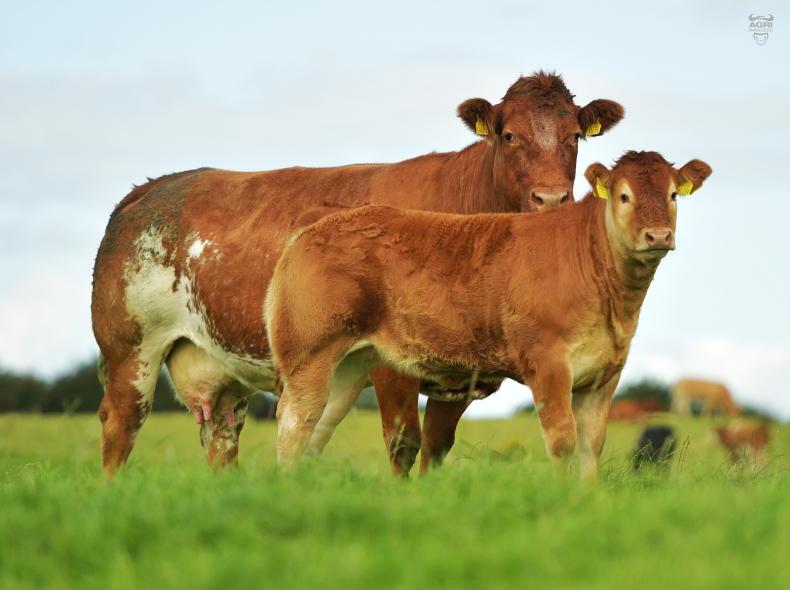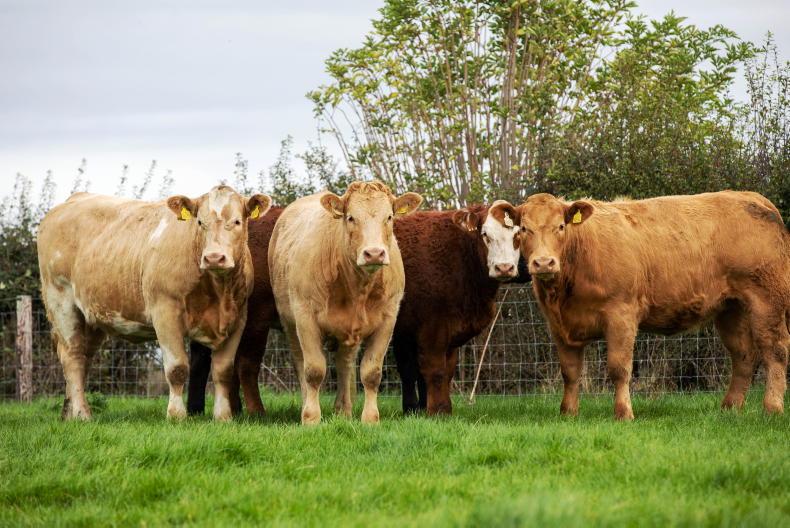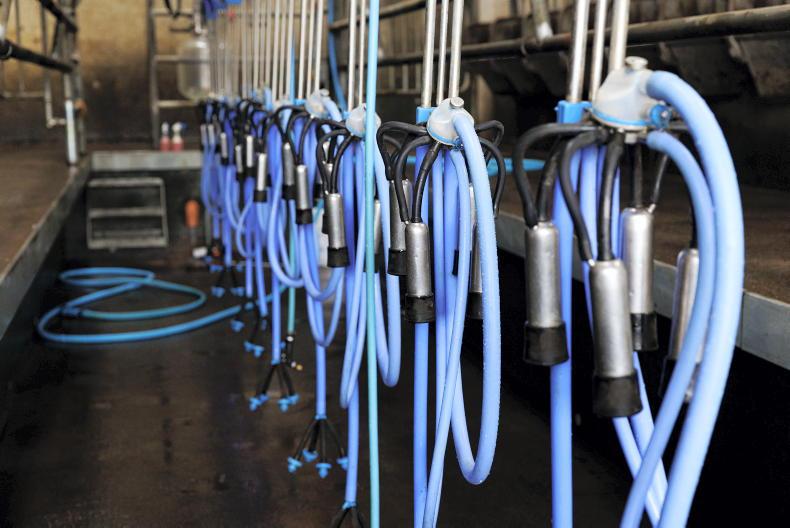The term “myostatin” has increasingly been thrown about in recent years, whether at sales or in AI catalogues. While the majority have little knowledge of the gene, testing has become common practice due to its ease.
That said, the double-muscling syndrome myostatin is not a new phenomenon. Indeed, it was first documented 200 years ago.
In cattle, double-muscling is largely due to the loss of function of the myostatin gene, which, in turn, is due to a mutation in the gene.
Most of the major breeds in Ireland have already been identified as carrying a mutation in the myostatin gene and show hereditary double-muscling.
In total, there are nine known mutations. These genes only come to full expression and effect when an animal carries two copies of the same mutation.
As one gene comes from the sire and one from the dam, cattle can have three different profiles, non-carrier (N – no copies of the gene), single-version carrier (C – one copy of the gene) and double-muscled (DM – two copies of the gene).
Below is an outline of the potential outcomes when crossing animals with different gene profiles for myostatin.
What happens if you breed an N animal to another non-carrier animal?
100% of the calves will be non-carriers.
What do you get if you breed an N with a C?
There is a 50% chance of getting N. There is a 50% chance of getting C
What do you get if you breed a C to a C?
There is a 25% chance of getting a DM. There is a 25% chance of getting N. There is a 50% chance of getting a C.
What do you get if you breed a C to a DM?
There is a 50% chance for DM and a 50% chance of getting a C.
The key benefit of double carriers of the myostatin gene is the improvement of all the economically relevant traits such as increased carcase yield, higher proportion of valuable cuts, improved muscle to bone ratio and dressing percentage.
Looking at the negative side, double-muscled calves increase potential calving problems due to increased birth weight and double-muscled females kept for breeding have a higher chance of having poor fertility and lower milk.
What’s worth noting, however, is that any research carried out on single-version carriers showed increased carcase value without the calving problems and cows that had similar maternal performance to non-carriers.
Therefore, for some beef breeds, undoubtedly there are advantages to be gained from breeding heterozygote animals due to their increased retail beef yield and production efficiency.
Commercial buyers need to make themselves aware of these genes before striking off a possible purchase.
Participants in the BDGP scheme have the option of myostatin testing all of their genotyped females for as little as €6 each. By doing this, it means you can purchase a bull that could add significantly to your bottom line.
Much of the negatives surrounding myostatin come from the perception that it affects calving traits. A lot of this only occurs in the scenario where a double carrier of a gene is born.
By identifying single carriers in your herd, you can avoid selecting single-version carrier bulls for that same gene.
This means added carcase weight and added conformation without added calving difficulties.
The majority of all AI bulls now have a myostatin status printed alongside each bull, meaning it’s easier than ever.
Q204X: animals with two copies of the gene (ie Q204X/Q204X) will exhibit characteristics of larger loin depth, reduced fat cover and greater meat tenderness. However, they may also have the potential to exhibit larger birth weight and, in females, slightly reduced milking ability. NT821: animals with two copies of the gene (ie nt821/nt821) will exhibit characteristics of larger loin depths, reduced fat depths and large, rounded rump and thighs. Animals with two copies may also have slightly heavier birth weights bringing with it the potential for more difficult calvings.F94L: animals with two copies of this gene (ie F94L/F94L) exhibit an increase in muscling (by up to 19%) with no associated increase in calving difficulty, lowered fertility or longevity.E226X: animals with two copies of the gene (ie E226X/E226X) will exhibit characteristics of larger loin depth, reduced fat depth and large, rounded rump and thighs. Animals with two copies may also have slightly heavier birth weights, with the potential for more difficult calvings. Two further variants of Myostatin exist in the population but are relatively uncommon in their occurrence. Known as nt419, E291X and C113Y, their effects are similar to nt821 and Q204X, respectively.
Read more
Irish rare breeds get new herdbooks
How can Johne's disease be controlled?
The term “myostatin” has increasingly been thrown about in recent years, whether at sales or in AI catalogues. While the majority have little knowledge of the gene, testing has become common practice due to its ease.
That said, the double-muscling syndrome myostatin is not a new phenomenon. Indeed, it was first documented 200 years ago.
In cattle, double-muscling is largely due to the loss of function of the myostatin gene, which, in turn, is due to a mutation in the gene.
Most of the major breeds in Ireland have already been identified as carrying a mutation in the myostatin gene and show hereditary double-muscling.
In total, there are nine known mutations. These genes only come to full expression and effect when an animal carries two copies of the same mutation.
As one gene comes from the sire and one from the dam, cattle can have three different profiles, non-carrier (N – no copies of the gene), single-version carrier (C – one copy of the gene) and double-muscled (DM – two copies of the gene).
Below is an outline of the potential outcomes when crossing animals with different gene profiles for myostatin.
What happens if you breed an N animal to another non-carrier animal?
100% of the calves will be non-carriers.
What do you get if you breed an N with a C?
There is a 50% chance of getting N. There is a 50% chance of getting C
What do you get if you breed a C to a C?
There is a 25% chance of getting a DM. There is a 25% chance of getting N. There is a 50% chance of getting a C.
What do you get if you breed a C to a DM?
There is a 50% chance for DM and a 50% chance of getting a C.
The key benefit of double carriers of the myostatin gene is the improvement of all the economically relevant traits such as increased carcase yield, higher proportion of valuable cuts, improved muscle to bone ratio and dressing percentage.
Looking at the negative side, double-muscled calves increase potential calving problems due to increased birth weight and double-muscled females kept for breeding have a higher chance of having poor fertility and lower milk.
What’s worth noting, however, is that any research carried out on single-version carriers showed increased carcase value without the calving problems and cows that had similar maternal performance to non-carriers.
Therefore, for some beef breeds, undoubtedly there are advantages to be gained from breeding heterozygote animals due to their increased retail beef yield and production efficiency.
Commercial buyers need to make themselves aware of these genes before striking off a possible purchase.
Participants in the BDGP scheme have the option of myostatin testing all of their genotyped females for as little as €6 each. By doing this, it means you can purchase a bull that could add significantly to your bottom line.
Much of the negatives surrounding myostatin come from the perception that it affects calving traits. A lot of this only occurs in the scenario where a double carrier of a gene is born.
By identifying single carriers in your herd, you can avoid selecting single-version carrier bulls for that same gene.
This means added carcase weight and added conformation without added calving difficulties.
The majority of all AI bulls now have a myostatin status printed alongside each bull, meaning it’s easier than ever.
Q204X: animals with two copies of the gene (ie Q204X/Q204X) will exhibit characteristics of larger loin depth, reduced fat cover and greater meat tenderness. However, they may also have the potential to exhibit larger birth weight and, in females, slightly reduced milking ability. NT821: animals with two copies of the gene (ie nt821/nt821) will exhibit characteristics of larger loin depths, reduced fat depths and large, rounded rump and thighs. Animals with two copies may also have slightly heavier birth weights bringing with it the potential for more difficult calvings.F94L: animals with two copies of this gene (ie F94L/F94L) exhibit an increase in muscling (by up to 19%) with no associated increase in calving difficulty, lowered fertility or longevity.E226X: animals with two copies of the gene (ie E226X/E226X) will exhibit characteristics of larger loin depth, reduced fat depth and large, rounded rump and thighs. Animals with two copies may also have slightly heavier birth weights, with the potential for more difficult calvings. Two further variants of Myostatin exist in the population but are relatively uncommon in their occurrence. Known as nt419, E291X and C113Y, their effects are similar to nt821 and Q204X, respectively.
Read more
Irish rare breeds get new herdbooks
How can Johne's disease be controlled?









SHARING OPTIONS